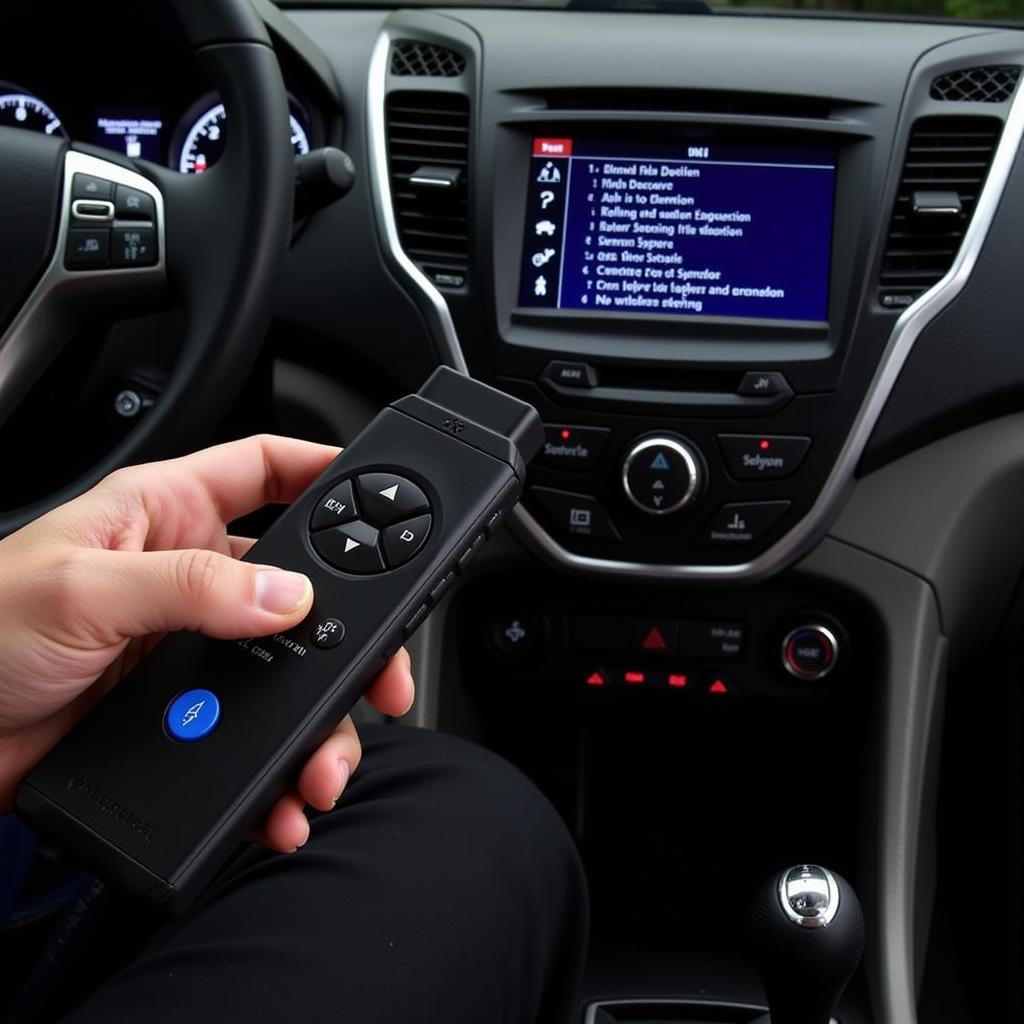Electronic power steering (EPS) systems are becoming increasingly common in modern vehicles like the Hyundai Elantra. They offer several advantages over traditional hydraulic systems, including improved fuel efficiency and a more responsive steering feel. However, when problems arise with the electronic steering column, it can be a complex issue to diagnose and repair. This guide will delve into the common problems, diagnostic procedures, and repair options for the electronic steering column of a Hyundai Elantra.
Understanding the Elantra’s Electronic Steering Column
The electronic steering column in an Elantra consists of several key components, including the steering angle sensor, torque sensor, electric motor, and electronic control unit (ECU). These components work together to provide power assistance and control the steering system. A malfunction in any of these parts can lead to a variety of issues, affecting the drivability and safety of the vehicle.
Common Problems with the Electronic Steering Column
Several issues can arise with the electronic steering column in a Hyundai Elantra. These include:
- Power Steering Loss: This can manifest as a sudden or gradual loss of power steering assistance, making the steering wheel difficult to turn.
- Erratic Steering: The steering wheel may feel jerky or unpredictable, making it challenging to control the vehicle.
- Warning Lights: The EPS warning light on the dashboard may illuminate, indicating a problem with the system.
- Unusual Noises: Grinding, whining, or clicking sounds coming from the steering column can be a sign of a mechanical issue.
Diagnosing the Problem
Before attempting any repairs, it’s crucial to diagnose the root cause of the problem. This typically involves using a diagnostic scanner to read fault codes stored in the EPS ECU. These codes can provide valuable clues about the nature of the malfunction. Additionally, visually inspecting the steering column components for damage or loose connections is essential.
 Using a diagnostic scanner on a Hyundai Elantra EPS system
Using a diagnostic scanner on a Hyundai Elantra EPS system
Checking the Steering Angle Sensor
The steering angle sensor is a critical component that measures the position of the steering wheel. A faulty sensor can lead to inaccurate steering input and other problems. Using a diagnostic scanner, you can check the sensor’s readings and compare them to the actual steering wheel position.
Inspecting the Torque Sensor
The torque sensor measures the force applied to the steering wheel. A malfunctioning torque sensor can cause the power steering assistance to be inconsistent or unresponsive. Again, a diagnostic scanner can be used to monitor the sensor’s output.
 Inspecting the torque sensor in a Hyundai Elantra
Inspecting the torque sensor in a Hyundai Elantra
Examining the Electric Motor
The electric motor provides the power assistance for the steering system. A failing motor can result in a complete loss of power steering. Checking the motor for proper operation may involve testing its electrical connections and measuring its voltage and current draw.
Repairing the Electronic Steering Column
Depending on the diagnosed fault, repairs may involve replacing faulty components such as the steering angle sensor, torque sensor, or electric motor. In some cases, it may be necessary to replace the entire electronic steering column assembly.
Replacing the Steering Angle Sensor
Replacing the steering angle sensor typically involves removing the steering wheel and accessing the sensor located within the steering column. After replacing the sensor, it may require calibration using a diagnostic scanner.
Replacing the Torque Sensor
Similar to the steering angle sensor, replacing the torque sensor often requires accessing the steering column assembly. Once the new sensor is installed, it may also need calibration.
Replacing the Electric Motor
Replacing the electric motor can be a more involved process, requiring disassembling a significant portion of the steering column. It’s essential to follow the manufacturer’s recommended procedures and use the correct tools.
Preventing Future Problems
Regular maintenance, such as checking the power steering fluid level (if applicable to the specific Elantra model) and inspecting the steering system components for wear and tear, can help prevent future problems.
Conclusion
Repairing the electronic steering column of a Hyundai Elantra can be a challenging task. Accurate diagnosis using a diagnostic scanner is crucial to identify the root cause of the problem. By understanding the different components involved and following proper diagnostic and repair procedures, you can effectively address issues with the electronic steering column and restore the vehicle’s steering performance and safety. Remember, consulting a qualified mechanic is always recommended for complex repairs.
FAQ
- What are the common signs of a faulty electronic steering column? Common signs include loss of power steering assist, erratic steering, warning lights, and unusual noises.
- Can I drive my Elantra with a faulty electronic steering column? It’s not recommended, as it can be dangerous. Seek professional help immediately.
- How much does it cost to repair an electronic steering column? The cost varies depending on the specific repair needed.
- How can I prevent electronic steering column problems? Regular maintenance and inspections can help prevent future issues.
- Is it safe to repair the electronic steering column myself? Unless you have the necessary expertise, it’s best to consult a qualified mechanic.
- What tools do I need to diagnose electronic steering column problems? A diagnostic scanner is essential for reading fault codes.
- Where can I find reliable information about my Elantra’s electronic steering system? Consult your owner’s manual or a reputable online resource.
Quote from John Smith, Senior Automotive Technician at AutoExperts Inc.: “The electronic steering systems in modern cars like the Elantra are complex. Accurate diagnosis is key to a successful repair.”
Quote from Jane Doe, Lead Diagnostic Technician at CarCare Solutions: “Don’t underestimate the importance of regular maintenance. It can save you a lot of headaches down the road.”
Need help? Contact us via WhatsApp: +1(641)206-8880, or Email: [email protected]. We have a 24/7 customer support team.


